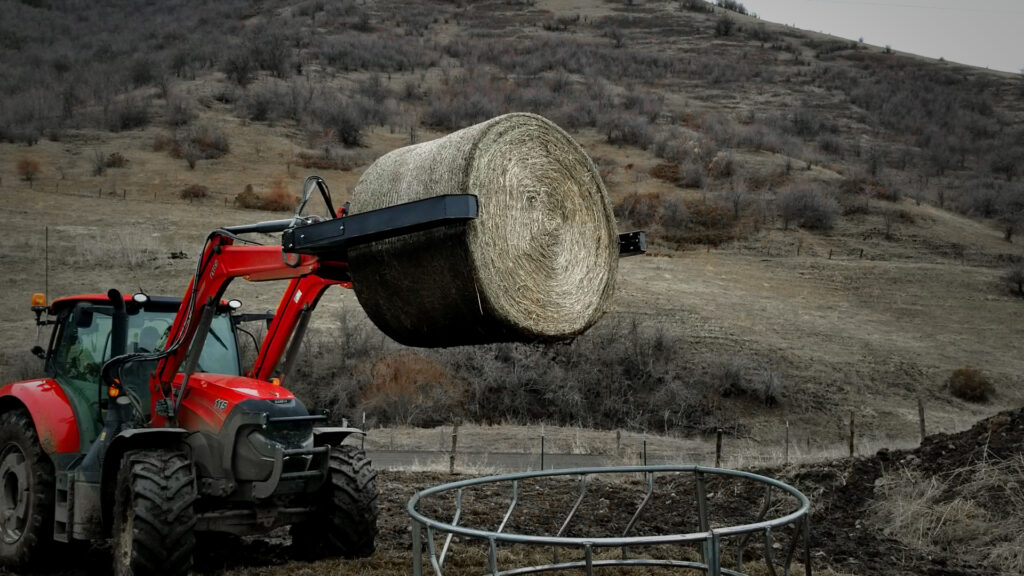Hillco Wrap Twine Remover Benefits

Hillco Wrap Twine Remover
Cattle ranching has been an essential part of human civilization since the beginning of time. With advancements in technology, necessary daily ranching tasks have become more efficient and effective, resulting in healthier animals, better genetics, improved nutrition and much more.
One of the most plodding and often repetitive tasks faced by ranchers is the removal of twine and net wrap from bales of hay or straw before use. The primary reason for the removal of twine and net wrap is to keep the cattle from ingesting it. The Hillco Technologies Wrap Twine Remover (WTR) offers an attractive way of removing the wrap and twine without the operator needing to get off and on the tractor.
About Hillco Technologies Wrap Twine Remover
The Hillco Technologies Wrap Twine Remover is an attachment that removes twine and net wrap from large round bales or large square bales quickly and efficiently without the need for the operator to get off the tractor. The WTR is mounted on the front of the tractor and is powered by the tractor’s hydraulic system. The 12-volt power supplied by the tractor allows the operator to switch between the 3 functions of cutting/grabbing, squeezing, and arm rotation.
The WTR uses a unique cutting and grabbing system that cleanly slices through the twine and net wrap, leaving the bale intact. On the right arm of the WTR there is a blade that cuts the wrap or twine and the left arm is lined with depth adjustable hooks that simultaneously grab the wrap or twine and hold it until the operator chooses to release it.
Top 5 Benefits of the Hillco Technologies Wrap Twine Remover
- Cattle Health
The number one reason that cattle ranchers benefit from the Hillco Wrap Twine Remover is reducing the risk of death or illness from cows ingesting the wrap or twine. Cows aren’t picky and have no problem eating twine and net wrap however they’re unable to digest it and it can lead to illness and even death.
2. Saves Time and Labor
Traditionally, ranchers remove twine and net wrap from bales manually, which is a time-consuming and labor-intensive task. Before feeding or using each bale, the operator is required to get off the tractor to cut and remove the net wrap or twine. With the Hillco WTR, they can now remove twine and net wrap from bales quickly and efficiently, without the need to get on and off the tractor.
3. Improves Safety
There are multiple safety measures that are important to consider that the use of the WTR reduces and/or eliminates. Firstly, the task of getting on and off the tractor in often thick, slippery muck, mud, and manure is eliminated which greatly reduces the risk of falling and injuring the operator. Secondly, removing the net wrap or twine manually requires the use of sharp knives in often slippery, cold, wet conditions and the WTR handles the cutting and removal without the need for the operator to handle such tools. And lastly, there is some risk when getting out among a herd of cattle and by safely remaining in the tractor the risk of getting stepped on, pushed around, knocked over or even trampled is mitigated with the use of the WTR.
4. Preserves Bale Quality
There is not another option on the market that removes the net wrap and twine while leaving the bale intact, as the WTR does. The only other options available that offers some of the same benefits actually cut the bale completely in half which and thus must be positioned in place upon splitting. The Hillco WTR does not cut the bale in half and allows the bale to be placed directly into the feeder or tub grinder without being destroyed prior to placement and with the squeeze function there is the opportunity to reposition or even move to another feeder without losing the entire bale.
5. Cost-Effective
The Hillco Technologies Wrap Twine Remover is a one-time investment that pays for itself in the long run. It eliminates the need for manual labor, increases safety of the operator, and saves time and money for cattle ranchers.
Conclusion
The Hillco Technologies Wrap Twine Remover is an innovative attachment that has revolutionized the way ranchers remove the twine and net wrap from bales of hay or straw. Its time-saving, labor-saving, and cost-saving features make it a superior tool for ranchers. The ability to preserve bale quality and improve safety makes it a valuable investment for any cattle operation. Interested in the WTR? Give us a call at 800-937-2461

